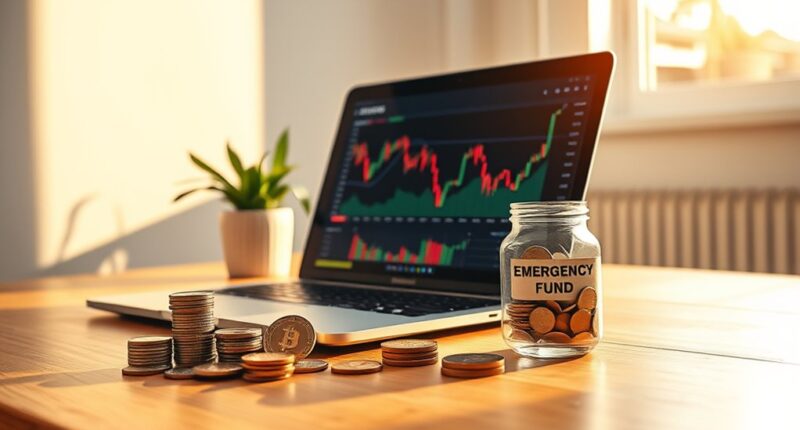To beat the bear market, start by setting a goal to save 3 to 6 months of living expenses in a dedicated, secure wallet or account. Automate regular contributions from your income to build this fund quickly. Keep your emergency savings in stable, liquid assets like cash or stablecoins to minimize risk. Stay disciplined and avoid investing all extra cash into risky assets during downturns. Keep going, and you’ll discover more strategies to strengthen your financial safety net.
Key Takeaways
- Set a clear goal to save 3-6 months of living expenses as your crypto emergency fund.
- Automate consistent weekly or monthly contributions to build the fund steadily within 30 days.
- Allocate funds into stable assets like cash or stablecoins for safety and quick access during crises.
- Minimize risky crypto holdings in the emergency fund to protect against market volatility.
- Regularly review and adjust your savings plan to stay on track and meet your emergency fund target.

Have you ever considered what you’d do if your crypto investments suddenly plummeted or you faced an unexpected financial emergency? Building a crypto emergency fund is essential to protect yourself during market downturns or personal crises. The first step is understanding the importance of risk management. Crypto markets are highly volatile, and your investments can fluctuate dramatically in a short period. By establishing an emergency fund, you create a financial buffer that allows you to cover necessary expenses without needing to sell your crypto holdings at a loss or during a downturn. This approach minimizes emotional decision-making and helps you maintain a clear investment strategy.
Building a crypto emergency fund safeguards against market drops and financial surprises.
To start, you need to determine how much cash you should set aside. A good rule of thumb is to save enough to cover three to six months of living expenses. This amount provides peace of mind and flexibility if unforeseen events occur. Once you have a target figure, open a dedicated savings account or use a secure, liquid wallet to keep this emergency fund separate from your investment portfolio. The key is ensuring quick access when needed, without risking the value of your investments.
Next, focus on portfolio diversification. While your main crypto holdings might be concentrated in a few assets, your emergency fund should be kept in more stable, less volatile assets. Diversification doesn’t mean spreading your investments across different cryptocurrencies alone; it also involves including traditional assets like cash or stablecoins. This reduces risk by balancing high-risk crypto investments with safer options, so your emergency fund remains intact regardless of crypto market swings. By diversifying, you lower the chance that a sudden crash in one asset class will wipe out your entire emergency fund.
Saving for your emergency fund requires discipline. Set aside a portion of your income regularly, and automate this process to ensure consistency. When the market is bullish, resist the temptation to invest all your extra cash into high-risk crypto assets. Instead, funnel a steady amount into your emergency fund until you reach your goal. Additionally, understanding the affairs – cheating husband secrets can help you recognize the importance of safeguarding your financial and emotional well-being in unpredictable situations. Once established, review and adjust your fund periodically to ensure it still covers your needs. Remember, having this safety net isn’t just about avoiding panic selling; it’s about taking control of your financial security.
Frequently Asked Questions
How Much Should I Initially Save for My Crypto Emergency Fund?
When starting your crypto emergency fund, you should save enough to cover at least three to six months of living expenses, based on your risk assessment. Your initial savings should be realistic and aligned with your investment strategy, considering your income and expenses. Focus on building this fund steadily, adjusting as needed, so you’re prepared for market downturns and unpredictable expenses, ensuring financial stability in uncertain times.
What Are the Best Cryptocurrencies to Hold for Emergencies?
When choosing cryptocurrencies for emergencies, you want assets with high crypto liquidity, stable market volatility, and widespread acceptance. Focus on established options like Bitcoin and Ethereum—these tend to have lower volatility and are easier to sell quickly. Avoid volatile altcoins, which can dip suddenly. Prioritize assets that are easy to access, quick to convert, and reliable in tough times, ensuring your emergency fund stays resilient when you need it most.
Can I Use Defi Platforms to Build My Emergency Fund?
Yes, you can use DeFi platforms to build your emergency fund, but you need to prioritize DeFi security and liquidity management. Choose reputable platforms with strong security measures to protect your assets. Keep enough liquidity on hand so you can access funds quickly during emergencies. Regularly review your investments and diversify across different DeFi projects to reduce risks and make sure your emergency fund remains accessible when you need it most.
How Often Should I Review and Adjust My Crypto Emergency Fund?
Imagine you’re sailing through stormy seas; just like a ship needs regular check-ups, you should review your crypto emergency fund often. Due to market volatility, it’s wise to reassess monthly or quarterly, ensuring your investments stay diversified and aligned with your financial goals. Adjust your fund accordingly, adding or withdrawing assets as needed, so you’re always prepared for sudden market shifts and can maintain a solid financial safety net.
What Are Common Mistakes to Avoid When Creating a Crypto Emergency Fund?
When creating a crypto emergency fund, avoid common mistakes like neglecting risk assessment and ignoring diversification strategies. Don’t put all your funds into a single coin, as this increases risk. Also, don’t underestimate market volatility or fail to research thoroughly. Instead, evaluate your risks carefully, diversify your investments wisely, and keep some liquidity handy. This approach helps safeguard your fund during downturns and ensures you’re prepared for unexpected emergencies.
Conclusion
Building a crypto emergency fund in 30 days is totally doable, even if you think you’re too busy or unsure where to start. Just stay consistent, prioritize your savings, and stick to your plan. Remember, even a small fund can provide peace of mind during tough times. Don’t let the fear of initial small steps hold you back—every bit counts, and you’ll be better prepared to weather any market storm.









